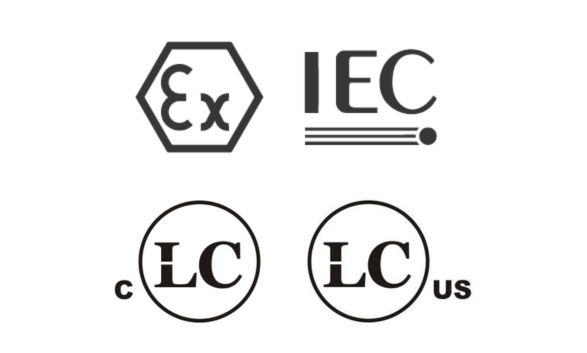HazLoc Certification – Why It Matters And How To Get It
Obtaining a HazLoc (Hazardous Locations) certification can prevent serious accidents. We are here to highlight the importance of a HazLoc certification, a regulatory requirement that demonstrates that electrical equipment complies with the applicable standards requirements for environments with explosion risks.
This article will explore what constitutes a hazardous location, why compliance is essential, how to obtain your HazLoc certification, and the certification process at LabTest. We understand that getting this certification may seem daunting, so we’re here to guide you through each step of the process. Together, let’s move toward safer workplaces.
Key Takeaways
- Acquiring a HazLoc certification is essential for electrical equipment in hazardous locations to prevent explosion risks.
- LabTest is an accredited NRTL that provides HazLoc certification by evaluating products to published standards and assessing compliance to avoid ignition.
- A HazLoc certification signals safety for intended hazardous atmospheres, reassuring end users and regulators and limiting liability.
- LabTest facilitates global access for North American-certified products, including approvals for Europe (ATEX), the UK (UKCA), and international IECEx.
Understanding Hazardous Locations
According to NFPA standards, Hazardous locations are areas with potential explosive or flammable gases, vapours, dust, and flying fibres in the air. These locations can be found in various industries, such as petrochemical plants, oil rigs, gas stations, grain elevators, flour mills, sawmills, powder coating facilities, and mining operations.
The HazLoc classification serves as a compass, helping us navigate these hazardous areas. With our over 20 years of experience in hazardous locations equipment approvals and as an OSHA Nationally Recognized Testing Laboratory (NRTL), we fully understand that any carelessness in the design and installation of electrical equipment could result in potential compliance problems, endangering lives.
Importance of Compliance
Compliance ensures safety, significantly reduces risks, provides regulatory coverage, and limits liability. It’s crucial to understand that adhering to these standards helps safeguard people, property, and your business reputation.
Safety and Risk Reduction
We are a Nationally Recognized Testing Laboratory (NRTL) that meets Occupational Safety and Health Administration (OSHA) standards. At LabTest, we’re proud of our commitment to rigorous safety protocols and risk assessment processes that ensure products meet relevant safety and performance standards. A thorough evaluation offers the peace of mind that manufacturers, end users, and regulators crave in potentially dangerous environments. With our HazLoc Certification, you can confidently navigate hazardous locations while we handle the complexities of ensuring your hazloc product is compliant and as safe as can be.
Regulatory and Liability Coverage
Navigating the challenges of regulatory compliance and liability coverage might feel overwhelming, but with our guidance, it becomes easier. We ensure that your product meets all necessary regulatory requirements and industry standards.
Here’s how we simplify the certification process for you:
Streamlining Compliance:
- We guide you through codes and standards.
- We help identify necessary testing based on usage location.
Providing Legal Protection:
- Our HazLoc certification offers tangible proof of safety compliance, reducing product liability risks.
- The LabTest mark signifies adherence to rigorous evaluation processes, reassuring end users.
Our expert support simplifies complex processes, allowing you to focus on what you do best – innovating safely.
Obtaining HazLoc Certification
You’ll find securing HazLoc certification surprisingly straightforward, especially when you understand its critical importance in ensuring safety and compliance in hazardous environments. Our expertise simplifies this integral process.
Here’s a brief overview to guide your journey:

| Stage | Key Elements | Outcome |
|---|---|---|
| Sample Requirements | Defined by class, division, group, temperature rating | Suitable samples for testing |
| Documentation Process | Technical guidelines for design, markings, installation, user manual | Comprehensive documentation package |
| Testing Procedures | Rigorous evaluation against CSA, IEC, EN, UL standards and more | Compliance validation |
| Certification Timeline | Efficient coordination with LabTest ensures timely completion | Certified product ready for market |
| Cost Estimation | Determined by complexity of product & test requirements | Clear budgetary guidance |
| Post-Certification Support | Assistance with ongoing compliance, market expansions | Smooth transition to commercialisation |
Remember: timely submission prevents delays. Let’s get your product certified!
Global Access and Approvals
We’ll guide you toward international recognition once you obtain your North American approvals. Here’s how:
- For Europe, we’ll ensure compliance with ATEX requirements, and for the UK, we’ll address UKCA requirements.
- With our expertise in HazLoc standards training, we can keep your team updated on these crucial regulations.
- As a recognized member of the IECEx Scheme, LabTest can assist you with your international approvals, widening your product’s reach.
- The Unit Verification process fast-tracks limited production run approvals.
- Preliminary Design Reviews provide early feedback to prevent potential issues.
So with us by your side, you’re free to focus on what matters – creating excellent products for hazardous locations worldwide!
Special Considerations for Battery Testing

When testing batteries for use in these high-risk environments, there’s a whole new set of rules and considerations to remember. Just like with other product categories for use in hazardous locations, we assess batteries against ordinary locations requirements before delving into the specifics of hazardous locations methodology. This includes the evaluation of venting requirements for preventing explosions, charging circuits, polarity considerations, and short circuit currents, all designed to maintain safety in potentially explosive atmospheres.
After having done this for twenty years, we have created a way that we streamline component testing to focus on the most relevant safety criteria. Rather than going through a long list of exhaustive checks, we zero in on key areas that really matter for hazardous location safety. Components undergo specific tests to ensure they are fit for purpose, and we clearly outline what has been tested (and what hasn’t) in a Schedule of Limitations. Don’t worry about temperature ratings for individual components; those are assessed in the final product to ensure the entire unit is safe for use in hazardous locations.
To reiterate (in a more technical way), we limit component testing, focusing primarily on Annex B of 60079-0. Table B.1 lists all the applicable clauses that apply. Clause 13, of 60079-0 refers to Annex B. All components will have a Schedule of Limitations as this lists what the component is tested for and what it isn’t. Temperature class ratings are not required for components, as tests will be conducted on the final product, including the components.
Frequently Asked Questions
What are the penalties for non-compliance with HazLoc certification requirements?
Regulatory enforcement can lead to a suspension of the certification and consequent removal of the product from the market, international repercussions, business reputation damage, and even lawsuit potential. So, it’s crucial to stay within the guidelines for HazLoc certification.
How long does the certification process typically take with LabTest?
Certification prerequisites and process complexities vary, affecting time management. However, when all goes well, when there are no failures, and when the manufacturer provides the complete product information and samples, a typical HazLoc certification project could be completed in 4-6 weeks. Expedited options are available for urgent needs, and extensions can be applied for complex projects.
What specific types of equipment require HazLoc certification?
HazLoc certification is required for various product categories, including plant oil extraction equipment, programmable logic controllers, pumps, robotics, sensors, signalling equipment, wearable technologies, and wireless communication.
How frequently does a product need to be re-certified for HazLoc standards?
We’ll need to renew HazLoc certification when product modifications occur or HazLoc standards update. The recertification process depends on these triggers. Staying current with changes ensures compliance and safety.
What are the costs associated with obtaining a HazLoc certification from LabTest?
The cost varies with product complexity and on how many and which type of tests are required by the applicable standard.

For any questions about HazLoc Certification standards or to schedule a test, please contact us at info@labtestcert.com

